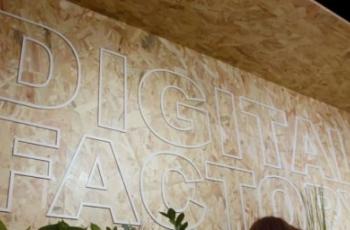05/19/2021
Michel Lutz, Group Data Officer at Total, recently posted on LinkedIn his thoughts about how data scientist jobs are changing. He feels that data are having an increasingly critical impact as they drive transformative changes in both organizations and society as a whole. At Total, data science and its representatives are having a major impact across the value chain, while helping to meet the Group’s Climate ambition. Michel Lutz tells us how.
How do you spend your days at Total?
I’ve been working for more than five years at Total, where I wear two hats. On one hand, as Group Data Officer, I define the broad outlines of the Group’s data-driven transformation. On the other, I’m in charge of the Total Digital Factory’s Data team, which comprises more than 30 people with advanced expertise in overseeing data, data management and data science projects. I’m very, very proud of all of them.
Does it annoy you when people say that the data scientist profession is in decline?
I know a lot about these data science jobs, which is why I took the liberty of posting my thoughts on LinkedIn about the supposed death of the data scientist profession. To my mind, it’s more about the end of all the marketing hype around data science. By that, I mean the idea that anybody can just style themselves a data scientist and that to extract value from your data, all you have to do is wave a magic wand. Data professionals and digital analysts will be in demand far into the future, even as their jobs become more complex. And I have to say that, whatever they’re called, we still need them as much as ever. A lot of young people are starting out on difficult degree programs, while seasoned professionals are retraining. We have to respect these people and think twice before proclaiming that their jobs are dead.
Clearly, however, the skills set required of a data scientist has evolved as the profession has steadily moved out of the lab and into operations. Data scientists are now expected to write clean code, manage their models once they are taken into production (what we call MLOps), efficiently integrate their models into human decision-making processes, and manage software/user interactions (what we increasingly refer to as MLUX). It is also very important for them to position themselves properly in the process of developing a decision support application, so they have to be able to work efficiently with data engineers, software developers, DevOps, data managers, product owners, etc.
Would you say that today, there is more than one kind of data scientist?
A data scientist’s traditional core competency has changed. We’ve backed away from the “all big data” or “all machine learning” models, because the issues encountered in the field often require a more sensitive approach. To address them, you need to use a whole range of analytical and modeling methods, including machine learning, of course, but also “old-school” statistics and probability studies, operational research and digital simulation, as well as the modeling of job-related rules and heuristics.
It’s all very enriching, and it makes the job exciting. Obviously, in practice, it’s rare for any one person to be an expert in all these areas. That’s why most of the time, you need an entire team that, together, delivers all these capabilities and can devise solutions to complex problems. You have to play well with others, as a team, and that’s how we work at the Total Digital Factory.
What is the job like at Total?
If data scientists are able to work so well together as part of the Total Digital Factory, it’s because they’re reaping the benefits of several years of data-related transformation projects. In recent years, for example, we’ve improved our technical platforms, which enable us to access data and deploy tools to mine their value, formed technological partnerships like the one with Microsoft, and steadily improved our data management processes, to secure the control and quality of our data. These complex, long-term projects are being led with Total’s IT Department and the Data Officers in charge of our main data categories – with their teams of course -. We are also being supported by the growing embrace of a data culture across the Group, which is a critical aspect that I am addressing, in particular with the Training Department. I would like to sincerely thank all the people who are working with me on these issues, which still offer us opportunities to meet some fascinating challenges.
All this flows seamlessly from the history of Total, which was already a major player in data before it ever heard of data science. In geosciences, for example, the Group has been working with seismic data for many years. Total also employs many engineers and scientists, so a data culture already permeates the organization. To get a better idea, take a look at this video, which clearly shows that data are everywhere at Total, regardless of the job.
Data are already highly integrated at Total, but how are they being used to support the energy transition and the Net Zero ambition?
At Total, we want to foster empowerment and facilitate access to data, which means access to the first level of data analytics. This is a fantastic driver of acceleration. Data shouldn’t be used or mined just by data scientists; they should be delivered to the front lines by getting our colleagues used to dealing with data in all their manifestations. This requires continuously training people and steadily upgrading our technology platforms. In addition, the Total Digital Factory is developing software that incorporates more complex tools and methods to harness data, in short six- to eight-month cycles, so that we can deliver additional software solutions to each job family. In this way, data can be used to support both employees in their jobs and the business lines in their strategies, thereby helping us to fulfill our Net Zero ambition.
Note that we have other ways of leveraging existing data in the Group, such as the centers of expertise located close to our business lines that help to deploy Total Digital Factory applications. We’ve set up an innovation center in India with Tata Consultancy Services, and our R&D teams are using data and artificial intelligence approaches to work on complex projects, such as modeling energy networks, designing new battery cells, and capturing and storing carbon.
What exactly are the Total Digital Factory projects supporting the energy transition?
While data are everywhere in the Group and application development is not restricted to the Total Digital Factory, the unit does move at its own pace, turning out 40 to 50 applications a year, with development cycles ranging from six to eight months. Let me give you some examples.
The VADER application – nothing to do with Star Wars –, calculates a refinery’s expected power and gas use, to help detect and predict overruns. In this way, our industrial facilities can manage their consumption more efficiently and shrink their carbon footprint. The data science models have been built incrementally, in direct interaction with users, who have validated each improvement to ensure that the data scientists actually deliver real-world benefits.
In another example, the SAFT4MATION application uses machine learning methods to optimize a battery plant’s production flows. It has had a strong transformative impact, with a plant employee now able to track upgrades to the model and ensure the quality of inputted data.
The wealth of data available to our Data Scientists, and increasingly to all employees, is an opportunity to put new technologies at the service of our historical expertise and thus shape the future of energy.
For this, Total Digital Factory is the ideal incubator, a unique space for creation and innovation within the Group.





